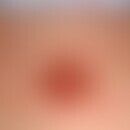Synonym(s)
Egyptian eye disease; Eye disease Egyptian; Grain disease
DefinitionThis section has been translated automatically.
Notifiable, chlamydia-related chronic conjunctivitis.
PathogenThis section has been translated automatically.
Chlamydia trachomatis, serotypes A, B, B, C.
You might also be interested in
EtiopathogenesisThis section has been translated automatically.
smear infection from person to person or via contaminated objects.
ClinicThis section has been translated automatically.
Conjunctival catarrh, grains up to 3 mm in size in swollen tissue in the conjunctiva of the eyelid and transitional fold. Grey, curtain-like opacity, advancing from the upper corneal edge. Scarred shrinkage and curvature of the tarsus, Entropium cicatricum.
DiagnosisThis section has been translated automatically.
Detection of Prowazek-Halberstadt inclusion bodies (Giemsa staining, inclusion body conjunctivitis), cell culture, complement fixation reaction, immunofluorescence.
Differential diagnosisThis section has been translated automatically.
Complication(s)(associated diseasesThis section has been translated automatically.
Blindness.
External therapyThis section has been translated automatically.
Apply antibiotic-containing ointments such as eye ointment containing tetracycline (e.g. aureomycin eye ointment) into the conjunctival sac every 2 hours.
Internal therapyThis section has been translated automatically.
- Tetracycline-HCl(e.g. Tetracycline Wolff): 4 times/day 500 mg p.o. over 7 days. Doxycycline (e.g. Doxy Wolff) is preferred because of its better absorption and tolerance, dosage 2 times/day 100 mg p.o. over 7 days.
- Alternatively (e.g. in case of tetracycline intolerance or pregnancy) erythromycin (e.g. Erythro-Hefa): 4 times/day 500 mg p.o. for 7 days, in case of intestinal intolerance reduction to 4 times/day 250 mg p.o. for 14 days.
- Azithromycin (e.g. Zithromax): 1 g p.o. as single dose.
LiteratureThis section has been translated automatically.
- Cossé MM et al (2018) One Face of Chlamydia trachomatis: The Infectious Elementary Body. Curr Top Microbiol Immunol 412:35-58.
- Guo W et al. (2016) Chlamydia gallinacea, not C. psittaci, is the endemic chlamydial species in chicken (Gallus gallus). Sci Rep 2016;6:19638.
- Gunn A et al (2016) Chlamydiaceae: an update on nomenclature. Vet Rec 179:193-194.
- Mattmann P et al. (2019) Chlamydiaceae in wild, feral and domestic pigeons in Switzerland and insight into population dynamics by Chlamydia psittaci multilocus sequence typing. PLoS One. 14(12):e0226088.
- Pannekoek Y et al. (2006) Inclusion proteins of Chlamydiaceae. Drugs Today (Barc) 42 Suppl A:65-73.
- Stalder S et al. (2020) Detection of Chlamydiaceae in Swiss wild birds sampled at a bird rehabilitation centre. Vet Rec Open 7(1):e000437.
Incoming links (5)
Bacteriae; Egyptian eye disease; Eye disease, egyptian; Grain disease; Symblepharon;Outgoing links (11)
Antibiotics; Azithromycin; Chlamydiaceae; Complement fixation reaction; Conjunctivitis; Doxycycline; Entropium; Erythromycin; Inclusion body conjunctivitis; Tetracycline; ... Show allDisclaimer
Please ask your physician for a reliable diagnosis. This website is only meant as a reference.




